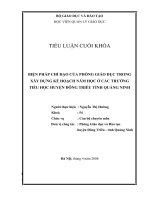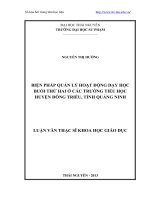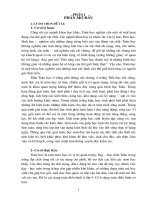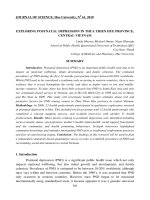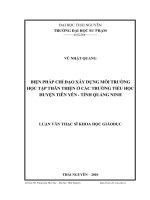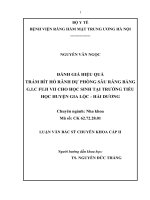gata5 unit2 website trường tiểu học hứa tạo đại lộc quảng nam
Bạn đang xem bản rút gọn của tài liệu. Xem và tải ngay bản đầy đủ của tài liệu tại đây (186.38 KB, 3 trang )
<span class='text_page_counter'>(1)</span><div class='page_container' data-page=1>
<b>Week: 3 UNIT 2: I ALWAYS GET UP EARLY. Planning Day:20/9/2016</b>
<b> HOW ABOUT YOU? Teaching Day:21/9/2016</b>
<b>Period:10 </b>
<b>Lesson 2- Part 1,2,3/p14 </b>
<b>I.Aim:</b> At the end of the period, Pupils will be able to ask and answer question about
frequency.
<b>II.Language focus:</b>
<i><b>1.</b></i> <b>Vocabulary</b>: surf the internet,information,once, twice, partner, project.
<i><b>2.</b></i> <b>Sentences pattern : How often do you study with a partner?</b>
<i><b> I study with a partner very day.</b></i>
<b>III.Resources: </b>Posters, flashcards, puppets, CD player.
<b>IV.Procedure:</b>
<b>Stages</b> <b>Steps of Activities</b> <b>Work </b>
<b>arrangement</b>
Warm-up : -Ps sing the song./p13 Whole class
<b>Part 1: </b>
<b>Look,listen </b>
<b>and repeat</b>
Pre- task :
- Introducing the topic :Getting up early.
- Teaching vocab:(stress/pronunciation/meaning)
+<i>surf the internet: vào mạng (picture)</i>
<i>+information</i>:/<i>inf</i>ə<i>’meiʃn/ thông tin(situation)</i>
+<i>once</i>/wʌns/ = one time<i>:một lần (synonym)</i>
<i>+twice</i>/twaɪs/=two times<i>: hai lần (synonym)</i>
<i>+partner</i>/ˈpɑːt.nər/<i>: bạn (picture)</i>
<i>+project</i>/ˈprɒdʒ.ekt/<i>: dự án(translation)</i>
<i>-</i>Checking vocab: ROR
-Setting the scene: ask Ps to identify the new characters
in the pictures and introduce the situation (Nam and
Linda are talking their frequence.)
- Playing the CD twice and asking Ps to repeat the
dialogue sentence by sentence.
-Having Ps practise the dialogue in pairs, then invite
some volunteers to play the roles in front of the class
(Correct the pronunciation errors when necessary).
- Making some questions to check Ps comprehension
of the language
-Setting the task <b>: </b> Modeling the structure :
<i><b> A:How often do you study with a partner?</b></i>
<i><b> B:I study with a partner every day.</b></i>
<i>- </i>Check form/ usage/ meaning.
<i>-</i>Ask Ps repeat a few times.
Whole class
Groupwork
Individually
Whole class
Whole class
Pair work
Individually
Pair work
Whole class
<b>Part 2 : Point </b>
<b>and say</b>
Task cycle :
- Having Ps look at the pictures in part 2 and identify
the characters in each picture.
- Have Ps read the word under the picture.
- Model the task with the whole class as an example:
<i><b>A: </b></i>How often do you go to the library?
</div>
<span class='text_page_counter'>(2)</span><div class='page_container' data-page=2>
<i><b>B:I go to the library </b></i>once a week .
*Technique : T-Ps; Ps-T; P1-P2
- Doing the task:
+Have Ps practice in pairs to ask and answer each other
using the picture as a cue.
+ Monitor and offer help when necessary.
- Planning report:
+ Inviting some Ps to demonstrate in front of the class.
+ The rest of class listen and comment
Open pair
Close pair
Pair work
Pair work
<b>Part 3: Let’s </b>
<b>talk</b>
-Having Ps look at the pictures on page 14, identify the
characters
- Ask Ps get what the children say
-Reminding the structures of asking, answering about
the frequency.
<i>A: What do you do in the evening?</i>
<i>B: I sometimes watch cartoon film.</i>
<i>A: How often do you go to the cinema?</i>
<i>B: I go to the cinema once a month.</i>
<i>- </i>Do example with one Ps
- Ask Ps work in Pair.
- Call on some pairs to perform at the front of the class.
- The rest of class listen and comment.
- Make a few questions to check pupils’ comprehension
of the language.
- Ask the whole class repeat all the sentences in chorus
to reinforce their pronunciation.
Whole class
Whole class
Individually
Pair work
Pair work
Individually
Whole class
Language
focus:
- Asking Ps to focus on the structures once again.
- Having Ps copy the structures in their notebooks
Whole class
Follow-up: - Giving Ps the game : “Slap on the board” Whole class
Home link: -Asking Ps to prepare Unit 2- Lesson 2/ Part 4,5,6
-Asking Ps to learn the new words and structures by
heart at home
- Asking do exercise E/p10 in WB.
Individually
Individually
</div>
<span class='text_page_counter'>(3)</span><div class='page_container' data-page=3></div>
<!--links-->
